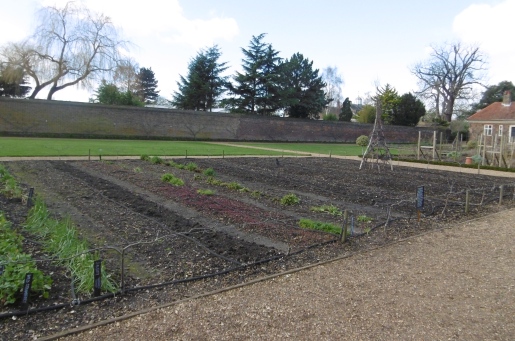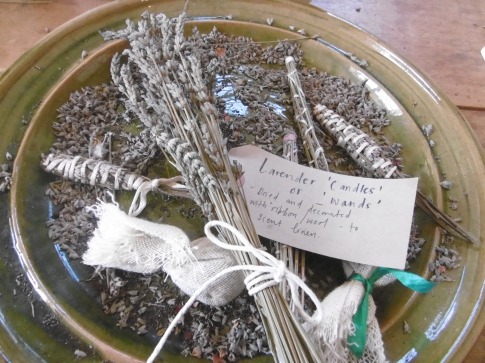 Yesterday I arrived down in Surrey again on dog-sitting duties. We don’t have a TV with iPlayer/On demand or whatever at home, but, of course, our son does! So I decided to “do catch-up”. I watched Lucy Worsley introducing The Romanovs [no longer available] and the Secret History of the British Garden. In the first episode Monty Don looks at 17th century gardens and, if you are in the UK, you can follow the link and from 23 minutes and 33 seconds into the programme see what I saw about Ham House Garden. I realised it was not a million miles away and decided to visit this morning.
Yesterday I arrived down in Surrey again on dog-sitting duties. We don’t have a TV with iPlayer/On demand or whatever at home, but, of course, our son does! So I decided to “do catch-up”. I watched Lucy Worsley introducing The Romanovs [no longer available] and the Secret History of the British Garden. In the first episode Monty Don looks at 17th century gardens and, if you are in the UK, you can follow the link and from 23 minutes and 33 seconds into the programme see what I saw about Ham House Garden. I realised it was not a million miles away and decided to visit this morning.
I’d also seen pictures of the stunning parterre, or, now as I know it, The Cherry Garden, in a couple books lately.
Title Page : The clipped garden at Ham House is simple but effective all the year through
Page 47 : The construction of the Hornbeam Tunnel round the Cherry Garden at Ham House is based on the assumption that these were a feature of late 17th century gardens rather than on documentary or archaeological evidence

The Hornbeam Tunnel in Winter
I couldn’t wait to see these beautiful parterres for myself and by the time I arrived (having driven twice round the centre of Kingston and been diverted from Ham Street) I expected to have missed the Garden Tour at 11am. But Gillian, the volunteer guide, was still waiting to see whether anyone would turn up so I had my own private tour.
“Free guided tours of Ham’s 17th Century formal gardens.”
After a brief introduction to the house and its history – which is important because it places Elizabeth, Duchess of Lauderdale in her context and she was very much responsible for the garden’s establishment and development and it was she who employed (John) Slezer and (Jan) Wyck, the designers, in 1671-72.
Here is the website description of the gardens:
“The 17th century gardens at Ham House have been restored to their former glory. With formal gardens and a walled kitchen garden, come and relax in an environment filled with plants from the time of the Duchess of Lauderdale.
Our restored kitchen garden
The kitchen garden has been at Ham since at least 1653 and is currently one of the most productive walled kitchen gardens in London. It provides our café with produce all year round, from purple-podded peas to salsify, skirret and scorzonera – we aim to be as true to the 17th century as we can.
The Cut Flower Plot provides all the flowers for our indoor arrangements and posies for the cafe tables
The restored 17th century beds containing produce popular then but that has fallen out of favour now
Wilderness
Seat in the Wilderness … just the place to think and read
The Wilderness was part of the original 17th-century garden and was a place to think and read.
The Wilderness is pretty bare in winter
Fruit espaliers on the Wilderness wall (apples and pears)
South terrace border
Our south terrace border is planted in the 17th-century style, with a wide seasonal interest.
Cherry garden [my personal favourite]
So called because there is evidence that in planters around the plot stood morello cherry trees. Note also that the lavender isn’t allowed to flower.
The Cherry Garden glimpsed through the surrounding yew hedge
Amongst the domes of lavender and santolina is a statue of Bacchus, the god of wine. [He’s wrapped up in the winter]
Garden produce
Visit the below stairs rooms in the house where you can feel, touch and smell our garden produce. Each week, the gardeners provide us with seasonal herbs and vegetables, fresh from the kitchen garden.”
Herbs drying in the Still Room
Medicinal Herb Knot Garden
Elizabeth, like all aristocratic women in the 17th century, had a duty to consider the well-being of everyone on her estate. Her Still House was used for preparing treatments from the medicinal plants in the garden. She was guided by the key writers of the time, such as Nicholas Culpeper (1616-54) author of The English Physician of 1653 (now known as Culpeper’s Herbal).
The Ham House Dairy
Inside the Dairy
The hand-painted 18th century tiles (Wedgwood Creamware) reminded me of those in the Dairy at Endsleigh
Ham House itself was also open but I spent too much time outside even though it was freezing cold so a repeat visit will have to planned … for a rainy day?
Coade Stone Pineapple


























A garden for all seasons; much here which is enhanced with the winter sparseness and empty flower beds.
I couldn’t agree more, Fran. I will just have to visit again … and again.
Hi Barbara, A great Blog and glad you enjoyed a venue in our neck of the woods. We often walk along the river and past the House. Alan took me in there for afternoon tea on my birthday, its a lovely place. Rosanna x
Hi, Rosanna. I loved it and will definitely return to see inside the house. Afternoon tea sounds like an excellent idea!
What a lovely spot!
Why won’t they let the lavender bloom?
I love the dairy. Are those little drawers on top of the legs under the counter? Such pretty tiles.
What a wonderful outing that was! Did Oliver go with you?
Yes, and it faces the River Thames, too. They won’t let the lavender flower because it must always look in neat little clumps and the spiky flowers would spoil that look. 17th Century gardens were to be looked at and admired. No, I don’t recall that they were drawers. Just fancy decoration. And no, I left Oliver at the house for a few hours. No dogs allowed.
aaah, so they probably didn’t grow the lavender that’s woven into dollies and drying in the shop…..
Poor little Oliver, he would have enjoyed frisking round the garden paths!
They did grow the lavender elsewhere – Walled kitchen garden and herb garden. But the Cherry Garden was for show. Yes. I wished he could have come with me. He would have been no trouble. But we went to other nice places together.
So Ham rather than Ham-pstead from now on 😏
Ha ha! I guess so. 🙂